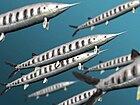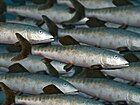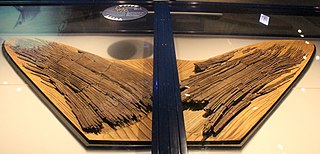
Leedsichthys is an extinct genus of pachycormid fish that lived in the oceans of the Middle to Late Jurassic. It is the largest ray-finned fish, and amongst the largest fish known to have ever existed.

Dapedium is an extinct genus of primitive neopterygian ray-finned fish. The first-described finding was an example of D. politum, found in the Lower Lias of Lyme Regis, on the Jurassic Coast of England. Dapedium lived in the late Triassic and Jurassic periods.

Hypsocormus is an extinct genus of pachycormid fish from the Middle to Late Jurassic of Europe. Fossils have been found in Germany, France and the UK.

Pachycormiformes is an extinct order of marine ray-finned fish known from the Early Jurassic to the end of the Cretaceous. It only includes a single family, Pachycormidae. They were characterized by having serrated pectoral fins, reduced pelvic fins and a bony rostrum. Pachycormiformes are morphologically diverse, containing both tuna and swordfish-like carnivorous forms, as well as edentulous suspension-feeding forms.

Aphanepygus is an extinct genus of prehistoric marine holostean ray-finned fish that lived during the upper Cenomanian. It inhabited the former Tethys Ocean, with remains known from Lebanon and Croatia. Its exact affinities are uncertain, although it is usually recovered as a relative of the macrosemiids. However, other authorities recover it in the Ionoscopiformes.
Bobbichthys is an extinct genus of marine ray-finned fish that lived in what is now Chile during the Oxfordian stage of the Late Jurassic epoch. It was a member of the Varasichthyidae, a family of potentially crossognathiform fish.
Chongichthys is an extinct genus of prehistoric marine ray-finned fish that lived during the Oxfordian stage of the Late Jurassic epoch. It contains one species, C. dentatus from the Quebrada El Profeta of Chile. It is named after Chilean geologist Guillermo Chong.
Oligopleurus is an extinct genus of prehistoric bony fish that lived during the Kimmeridgian stage of the Late Jurassic epoch.

Euthynotus is an extinct genus of prehistoric bony fish that lived during the early Toarcian stage of the Early Jurassic epoch. It is generally considered the basalmost pachycormiform.

Ainia is an extinct genus of prehistoric ray-finned fish that lived during the Kimmeridgian stage of the Late Jurassic epoch. It contains a single species, A. armata, known from the famous Solnhofen Limestone of Germany. It is a distant relative of the bowfin, although it is more closely related to genera such as Caturus and Osteorachis.
Scanilepis is an extinct genus of prehistoric bony fish that lived during the Rhaetian-?Hettangian ages. The type species, S. dubia, is known from the Rhaetian freshwater deposits of the Bjuv member of the Höganäs Formation, southwestern Sweden. A second species, S. spitzbergensis was mentioned from the Hettangian of the Festning section of the Grøfjorden area in Spitsbergen, Norway but was never described.
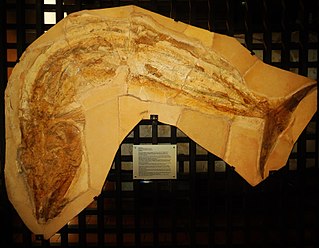
Asthenocormus is an extinct genus of large marine pachycormiform ray-finned fish. It contains a single species, A. titanius. A member of the edentulous suspension feeding clade within the Pachycormiformes, fossils have been found in the Upper Jurassic plattenkalks of Bavaria, Germany.

Anaethalion is an extinct genus of prehistoric marine and freshwater ray-finned fish related to modern tarpons and ladyfish. It is known from the Late Jurassic to the Early Cretaceous of Europe and northeasterrn Asia, roughly encompassing the Tethys Ocean.
Ascalabos is an extinct genus of marine ray-finned fish known from the Late Jurassic Solnhofen Limestone of Germany. It contains one species, A. voithii. Some authorities synonymize it with Leptolepis.
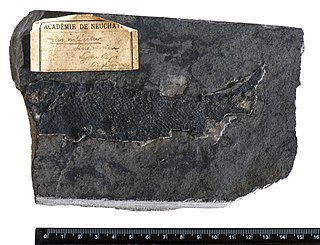
Cosmolepis is an extinct genus of prehistoric bony fish that lived during the Early Jurassic epoch in what is now England.
Ceramurus is an extinct genus of prehistoric marine ray-finned fish from the Late Jurassic. It contains a single species, C. macrocephalus from the Purbeck Group of England.

Prohalecites is an extinct genus of ray-finned fish from the Ladinian and possibly Carnian (Triassic) of Italy. It is the oldest known teleosteomorph, a group that includes extant teleosts and their close fossil relatives.
Ligulalepis is an extinct genus of prehistoric bony fish. Ligulalepis was first described from isolated scales found in the Taemas-Wee jasper limestones of New South Wales by Dr Hans-Peter Schultze (1968) and further material described by Burrow (1994). A nearly complete skull found in the same general location was described in Nature by Basden et al. (2000) claiming the genus was closely related to basal ray-finned fishes (Actinopterygii). In 2015 Flinders University student Benedict King found a more complete new skull of this genus which was formally described by Clement et al. (2018), showing the fish to be on the stem of all osteichthyans.
This list of fossil fishes described in 2013 is a list of new taxa of placoderms, fossil cartilaginous fishes and bony fishess of every kind that have been described during the year 2013. The list only includes taxa at the level of genus or species.
Martillichthys is an extinct genus of pachycormiform fish, known from the late Middle Jurassic (Callovian) Oxford Clay, England. It is a member of the suspension feeding clade within the Pachycormiformes, most closely related to Asthenocormus.














